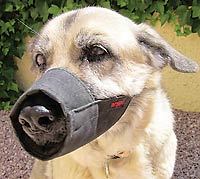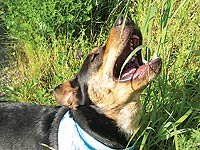 Can I use a muzzle to stop my dog from barking? Can I use a muzzle to stop my dog from barking?
The answer is not easy. There are two types of muzzles; one is a slip-on that keeps their mouth shut completely. Although this will stop your dog from barking, it will also keep them from being able to pant, and if a dog can’t pant they will overheat. The second type of muzzle is a basket muzzle; this will not keep your dog from barking at all. Basket muzzles are designed to prevent a bite but allow the dog to resume all other normal dog activity, like drinking water taking treats, and panting if they are hot. Slip-on muzzles are designed to keep your dog’s mouth shut for safety, and they should be used under supervision only. We use them occasionally in grooming if the dog indicates that they are uncomfortable with a procedure (like nail trimming), and they are never on the dog for more than a few minutes.
Although it’s tempting to use a muzzle for something like barking, it is far better to address barking behaviorally. Find out why the dog is barking first. Are they bored? Do they bark at the door when someone knocks? Do they bark at you for treats, food, toys, etc.? Once you’ve started answering some of these questions, you can move forward with teaching them not to bark. Barking is a strong instinct in most dogs, but excessive barking is not normal so it should be addressed. In my own dogs, they are very reactive to what is going on outside our fence. We want our dogs to alert when someone comes in our yard, but we don’t want them barking more than necessary. We worked with a trainer to allow a few barks, and then suppress anything beyond 3 or 4 woofs. It was a lot of work and we still need to refresh the training periodically but it worked and was worth our efforts. If you are looking for a solution for barking we have many other recommendations, muzzles are not one of them.
If I feed my dog Chicken (or any other small prey) flavored dog food, will they develop a taste for it and want to chase/or kill Chickens?
No, your dog is a predator by nature. If they do want to chase and or kill these small prey animals it has nothing to do with the flavor of their food, but rather their natural instincts. We get this question often and we can assure you that if you pick rabbit flavored dog treats or a fluffy stuffed toy bunny your dog is no more likely to want to chase rabbits, they would have done that anyway regardless of what they are fed or what toys they are given.
Unique proteins are becoming all the rage in dog food, some because of allergies dogs can have to certain proteins (chicken and beef are the most common, but still it’s a very rare thing to be allergic to proteins) and others for a pure novelty. Personally we like to feed venison to our own dogs, it’s a lean protein and it’s less likely to be raised with antibiotics. Neither of our dogs is allergic to proteins, we just like the stuff but you will never see my Dachshunds chasing down a deer because we fed them venison. Feed your dogs whatever healthy foods they like!
 Why does my dog eat grass? Why does my dog eat grass?
There are a few reasons dogs eat grass. The most common reason has to do with their tummy being upset. It is a dog’s natural instinct to try and throw up if they have tummy upset, and most grass is indigestible (insoluble fiber) so they use it to throw up. The one thing you need to be aware of is that if you fertilize your lawn, do not let your dog even nibble on that grass, the chemicals that make it a nice pretty green are toxic or even fatal to your dog. Make sure if you want a pristine fertilized lawn your dog is not inclined to eat the grass. We use fish poop to fertilize many of our plants and lawn, and our dogs love to eat it. It’s organic but still NOT ok for the dogs to eat.
If your dog eats grass and occasionally throws up it’s not a big concern, but if they do it more than once a month there may be something else you need to address. Dogs will also seek out greens as a digestive aid. If they are not eating enough to throw up, but you see them chewing on greens regularly they may need some digestive assistance. In this case you can add prebiotic and probiotics to their diet and it should help them curb the need to seek out greens. It’s far better to supplement their diet with digestive aids then allow them to eat random greens with who know what sprayed on them.
My dog drags their butt on the carpet, do they have worms?
There are two common but different reasons why dogs scoot their butt all over your carpet. The first and mostly likely answer is they are having trouble with their anal glands. This is far more common in small dogs, but all dogs have anal glands so it can be a problem for any size dog. When your dog scoots, their anal glands are most likely impacted and need to be expressed. Since your dog doesn’t have the ability to squeeze their glands they try and use their body weight against a soft surface to take care of it. Expressing glands should be done by someone who knows what they are doing like the vet or a groomer, but can also be done at home with training. We highly recommend doing it during bath time for easy clean up, as it can be a downright disgusting thing to do and it smells pretty bad. If a dog has chronic problems with their glands we suggest more soluble fiber in their diets. The glands are expressed each time a dog eliminates, if their poop is not solid enough it can lead to problems and adding fiber can help or even eliminate the problem.
The second common reason your dog scoots on the carpet is indeed they have worms. A fecal sample and diagnosis by the vet is the only way to determine the problem. You do not want to regularly deworm your dogs as the medication is harsh on the digestive tract and should only be used if necessary. Dogs usually get worms from eating scat or feces from an animal that is infested with worms. They can also get the worms directly from eating the animal or any part of an animal carcass. Since hiking is a common thing to do with your dog in Moab, digestive parasites are a pretty common problem here as well. There are other less common reasons for your dog to scoot their butt so if it’s a chronic problem, please consult your vet.
|